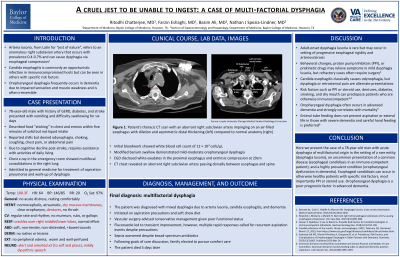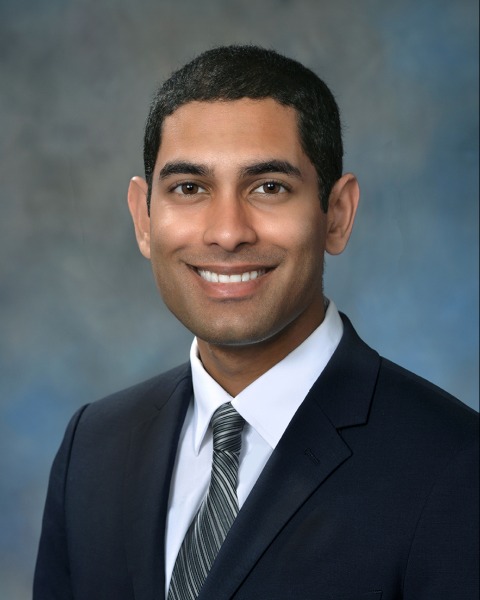Monday Poster Session
Category: Esophagus
P1897 - A Cruel Jest to Be Unable to Ingest: A Case of Multi-Factorial Dysphagia
Monday, October 23, 2023
10:30 AM - 4:15 PM PT
Location: Exhibit Hall

Has Audio

Ritodhi Chatterjee, MD
Baylor College of Medicine
Houston, Texas
Presenting Author(s)
Award: Presidential Poster Award
Ritodhi Chatterjee, MD, Farzin Eshaghi, MD, Basim Ali, MD, Nathaniel Spezia-Lindner, MD
Baylor College of Medicine, Houston, TX
Introduction: Dysphagia can be oropharyngeal or esophageal in origin but overlap exists. Arteria lusoria, from Latin for “jest of nature”, refers to an anomalous right subclavian artery causing dysphagia via esophageal compression with prevalence 0.4-0.7%. Candida esophagitis commonly affects immunocompromised hosts but can be seen in others with specific risk factors. Oropharyngeal dysphagia frequently occurs in dementia due to impaired sensation and muscle weakness and is often irreversible.
Case Description/Methods: A 78-year-old male with history of GERD, diabetes, and stroke presented with vomiting and difficulty swallowing for six days. The patient described food “sticking” in his chest and emesis within five minutes of solid but not liquid intake. He reported chills but denied odynophagia, choking, or coughing. Due to cognitive decline post-stroke, he required assistance with activities of daily living. Vital signs were notable for temperature of 100.3F. Physical exam revealed orientation to self and place only, dry mouth, dentures, and bibasilar crackles. Initial bloodwork showed white blood cell count of 12 × 103 cells/μL. Chest x-ray showed multifocal consolidations in the right lung consistent with aspiration pneumonia. Modified barium swallow confirmed mild-moderate oropharyngeal dysphagia. EGD disclosed white exudates in the proximal esophagus and extrinsic compression at 29cm. CT thorax revealed an aberrant right subclavian artery, completing diagnosis of mixed dysphagia due to arteria lusoria, candida esophagitis, and dementia. Vascular surgery advised conservative management. Fluconazole led to some improvement; however, emesis and sepsis progressed despite broad-spectrum antibiotics and aspiration precautions. Following goals of care discussion, family elected to pursue comfort care.
Discussion: Adult-onset dysphagia lusoria is unusual but may occur in setting of progressive esophageal rigidity and arteriosclerosis. Behavioral changes, proton pump inhibitors (PPI), or prokinetic drugs may relieve symptoms, but refractory cases often require surgery. Candida esophagitis classically causes odynophagia, but dysphagia or retrosternal pain are alternate presentations; risk factors such as PPI or steroid use, dentures, diabetes, smoking, and dry mouth can predispose immunocompetent patients. Oropharyngeal dysphagia often occurs in advanced dementia and strongly correlates with mortality, but enteral tube feeding does not prevent aspiration or extend life.

Disclosures:
Ritodhi Chatterjee, MD, Farzin Eshaghi, MD, Basim Ali, MD, Nathaniel Spezia-Lindner, MD. P1897 - A Cruel Jest to Be Unable to Ingest: A Case of Multi-Factorial Dysphagia, ACG 2023 Annual Scientific Meeting Abstracts. Vancouver, BC, Canada: American College of Gastroenterology.
Ritodhi Chatterjee, MD, Farzin Eshaghi, MD, Basim Ali, MD, Nathaniel Spezia-Lindner, MD
Baylor College of Medicine, Houston, TX
Introduction: Dysphagia can be oropharyngeal or esophageal in origin but overlap exists. Arteria lusoria, from Latin for “jest of nature”, refers to an anomalous right subclavian artery causing dysphagia via esophageal compression with prevalence 0.4-0.7%. Candida esophagitis commonly affects immunocompromised hosts but can be seen in others with specific risk factors. Oropharyngeal dysphagia frequently occurs in dementia due to impaired sensation and muscle weakness and is often irreversible.
Case Description/Methods: A 78-year-old male with history of GERD, diabetes, and stroke presented with vomiting and difficulty swallowing for six days. The patient described food “sticking” in his chest and emesis within five minutes of solid but not liquid intake. He reported chills but denied odynophagia, choking, or coughing. Due to cognitive decline post-stroke, he required assistance with activities of daily living. Vital signs were notable for temperature of 100.3F. Physical exam revealed orientation to self and place only, dry mouth, dentures, and bibasilar crackles. Initial bloodwork showed white blood cell count of 12 × 103 cells/μL. Chest x-ray showed multifocal consolidations in the right lung consistent with aspiration pneumonia. Modified barium swallow confirmed mild-moderate oropharyngeal dysphagia. EGD disclosed white exudates in the proximal esophagus and extrinsic compression at 29cm. CT thorax revealed an aberrant right subclavian artery, completing diagnosis of mixed dysphagia due to arteria lusoria, candida esophagitis, and dementia. Vascular surgery advised conservative management. Fluconazole led to some improvement; however, emesis and sepsis progressed despite broad-spectrum antibiotics and aspiration precautions. Following goals of care discussion, family elected to pursue comfort care.
Discussion: Adult-onset dysphagia lusoria is unusual but may occur in setting of progressive esophageal rigidity and arteriosclerosis. Behavioral changes, proton pump inhibitors (PPI), or prokinetic drugs may relieve symptoms, but refractory cases often require surgery. Candida esophagitis classically causes odynophagia, but dysphagia or retrosternal pain are alternate presentations; risk factors such as PPI or steroid use, dentures, diabetes, smoking, and dry mouth can predispose immunocompetent patients. Oropharyngeal dysphagia often occurs in advanced dementia and strongly correlates with mortality, but enteral tube feeding does not prevent aspiration or extend life.

Figure: Figure 1: Thoracic CT scan with aberrant right subclavian artery impinging on an air-filled esophagus with dilation and asymmetric distal thickening.
Disclosures:
Ritodhi Chatterjee indicated no relevant financial relationships.
Farzin Eshaghi indicated no relevant financial relationships.
Basim Ali indicated no relevant financial relationships.
Nathaniel Spezia-Lindner indicated no relevant financial relationships.
Ritodhi Chatterjee, MD, Farzin Eshaghi, MD, Basim Ali, MD, Nathaniel Spezia-Lindner, MD. P1897 - A Cruel Jest to Be Unable to Ingest: A Case of Multi-Factorial Dysphagia, ACG 2023 Annual Scientific Meeting Abstracts. Vancouver, BC, Canada: American College of Gastroenterology.


